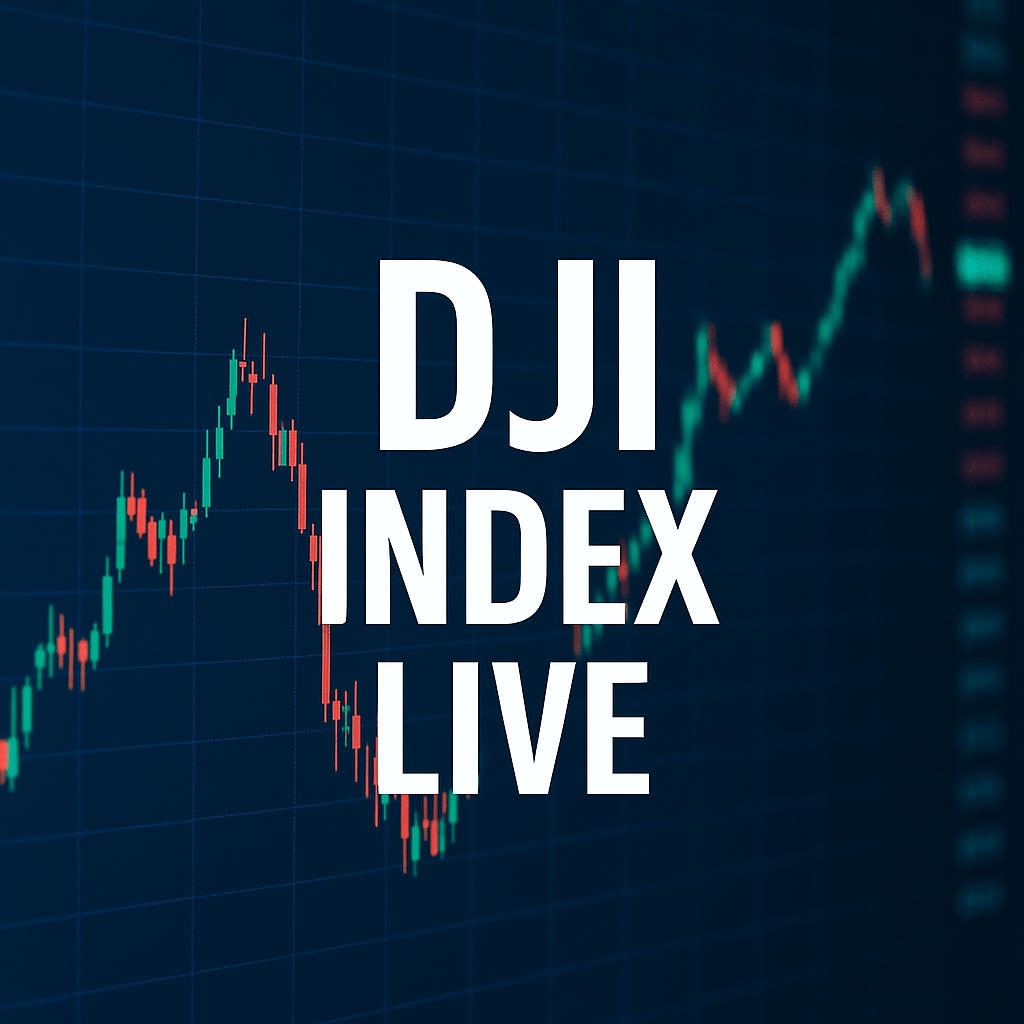Your cart is currently empty!
DJI index live

Monitoring the dji index live has become an essential practice for investors and traders seeking to capitalize on market fluctuations as they occur. In an era where financial markets move at lightning speed, having access to up-to-the-second data on the Dow Jones Industrial Average empowers market participants to make informed decisions rather than relying on delayed or end-of-day figures. Moreover, real-time tracking enables professionals and individual investors alike to identify trend shifts, gauge market sentiment, and respond to breaking news events with agility. As a premier resource for market updates, Rajeev Prakash delivers comprehensive coverage and expert insights into live market movements, ensuring that you stay ahead of the curve.
What Is the Dow Jones Industrial Average?
The Dow Jones Industrial Average (DJIA) stands as one of the most recognized stock market indices in the world. Comprising 30 leading publicly traded companies across diverse sectors, the DJIA offers a snapshot of overall market performance and economic health. Originally introduced in 1896, the DJIA has evolved alongside the U.S. economy, reflecting shifts from manufacturing to technology and beyond. Investors rely on the DJIA as a barometer for market trends, often using its performance to inform decisions about portfolio allocation, risk management, and long-term strategy. By understanding its composition and weighting methodology, market participants can interpret the significance of real-time changes more effectively.
Why Track dji index live Data?
Tracking the dji index live provides several distinct advantages. First, it eliminates the latency associated with end-of-day reports and periodic summaries, offering a continuous stream of price updates. Second, live data feeds facilitate more precise entry and exit points for trades, which can translate into tighter spreads and reduced slippage. Third, by observing intraday patterns, traders can detect momentum shifts, support and resistance levels, and volume spikes that may signal emerging opportunities or risks. In addition, institutional investors often integrate live DJIA data into algorithmic models, enabling systematic strategies that react to predefined conditions without human intervention. For those interested in in-depth live visuals and advanced charting, explore our dedicated Dow Jones Industrial Live page.
The Impact of Global Events on Live DJI Index
Global economic and geopolitical events exert a profound influence on the dji index live readings. Economic indicators such as employment reports, inflation data, and interest rate decisions by the U.S. Federal Reserve often trigger sharp intraday moves. Likewise, geopolitical tensions, trade negotiations, and unexpected developments in Europe or Asia can cause sudden spikes in volatility. For instance, announcements from the European Central Bank or shifts in Italian bond yields resonate through global equity markets, influencing the DJIA’s real-time trajectory. Therefore, maintaining awareness of scheduled events—such as nonfarm payroll releases or central bank press conferences—and unscheduled news breaks is critical. This vigilance ensures that investors can distinguish between transient noise and meaningful trend changes.
Technical Analysis with dji index live Information
Integrating live DJI index data into technical analysis frameworks enhances decision-making precision. Traders frequently employ moving averages, Bollinger Bands, and relative strength indicators to identify momentum and overbought or oversold conditions. By overlaying these tools on a live price chart, one can pinpoint potential reversal zones or breakout opportunities as they form. Moreover, intraday candlestick patterns—such as engulfing bars or doji formations—gain significance when viewed in real time, signaling market indecision or potential continuation. Volume analysis further enriches this perspective; sudden surges in trading volume accompanying price moves often confirm the validity of a breakout or breakdown. Consequently, merging live data with robust technical indicators fosters a dynamic trading environment where signals are validated immediately.
Using Live DJI Index for Investment Decisions
Long-term and short-term investors alike benefit from monitoring the dji index live. For swing traders, intraday fluctuations provide clear entry and exit markers, allowing them to capture moves over several hours or days. Day traders exploit microtrend reversals, arbitraging minor price gaps within a single session. Portfolio managers, meanwhile, can adjust sector allocations as live data reveals shifting market leadership. In every scenario, the capacity to observe live DJIA movements reduces uncertainty, enhances risk management, and increases the likelihood of executing trades at optimal levels. Furthermore, coupling live index data with global market screens—covering European, Italian, and UK benchmarks—allows multi-regional correlation analysis, informing hedging strategies and cross-market arbitrage.
Regional Market Sessions: US, UK, Italy, and Europe
Although the dji index live primarily reflects U.S. market hours, developments in the UK, Italy, and broader Europe set the tone for the New York session. European indices such as the FTSE 100 or the FSTE MIB often react to macroeconomic releases early in their trading day, establishing initial risk sentiment that carries over to U.S. markets. For instance, a surprise rate cut by the Bank of England or a change in Italian fiscal policy can alter investor expectations, causing ripple effects that manifest in the DJIA’s real-time performance. Moreover, currency fluctuations—particularly in the euro and pound sterling—affect multinational companies listed on the DJIA, impacting earnings projections and share valuations. By observing inter-market relationships, traders can anticipate live DJIA movements even before the U.S. bell rings.
Factors Driving Real-Time DJI Index Movements
Multiple factors drive real-time moves in the DJIA. Corporate earnings reports, mergers and acquisitions announcements, and strategic guidance from index constituents generate immediate market reactions. In addition, macroeconomic developments—ranging from U.S. GDP figures to global commodity price fluctuations—shape investor sentiment. Technological advancements in trading platforms, including algorithmic strategies and high-frequency trading, can amplify intraday swings, creating rapid but often short-lived price excursions. Meanwhile, social media sentiment and newswire algorithms increasingly influence market psychology, as breaking headlines trigger automated order flows. Recognizing this complex interplay of fundamentals, technicals, and sentiment is vital for interpreting the significance of live DJI index data.
Tips for Trading with Live DJI Index Data
When trading based on the dji index live feed, discipline and strategy alignment are paramount. First, define clear entry and exit criteria, ensuring that trades adhere to risk-reward parameters. Second, incorporate stop-loss orders to mitigate downside exposure when markets move against positions unexpectedly. Third, avoid overtrading by focusing on the most liquid market hours, typically within the first and last two hours of the U.S. session. In addition, consider using limit orders to secure preferred prices rather than market orders, which may incur slippage during volatile spikes. Lastly, maintain a trading journal documenting intraday decision points and outcomes, fostering continuous improvement over time.
Tools and Platforms for Accessing Live DJI Index Data
A multitude of trading platforms and financial news services provide live DJI index data. Broker interfaces often feature integrated charts, order entry tools, and real-time news feeds, enabling seamless trade execution. Independent charting applications offer customizable indicators and alerts, while mobile apps deliver push notifications for significant price moves. Furthermore, dedicated websites host live index tickers and commentaries, enriching data with expert analysis and contextual explanations. Selecting a platform that balances speed, reliability, and user experience is critical; latency issues can erode the advantages of real-time tracking, while user-friendly interfaces promote better decision-making.
Risk Management with Real-Time Market Data
While real-time data offers opportunities, it also introduces risks. Rapid market movements can trigger emotional reactions, leading to impulsive trades. Noise in the data—temporary spikes without fundamental backing—may result in false signals. To manage these risks, traders should employ tools such as volatility filters, which prevent overexposure during erratic sessions, and time-based filters that restrict trading to predefined intervals. In addition, diversifying strategies across multiple asset classes and timeframes reduces reliance on a single market signal. Ultimately, coupling live DJI index monitoring with robust risk controls preserves capital and sustains long-term success.
Adapting Strategies for Different Market Conditions
Market conditions vary from trending to range-bound environments. In trending markets, momentum-based strategies thrive, as live DJIA tracking reveals persistent directional moves. Conversely, in choppy or sideways markets, range-trading approaches perform better, capitalizing on price oscillations between support and resistance levels. Recognizing the prevailing market regime—through indicators such as average true range or trend strength metrics—enables traders to switch strategies dynamically. Moreover, live data feeds facilitate regime detection in real time, allowing for strategy adjustments within the same trading session.
Conclusion
In a financial landscape defined by rapid information flow and interconnected markets, the ability to track the dji index live is indispensable. Real-time access to DJIA movements empowers traders and investors across the US, UK, Italy, and Europe to seize opportunities, manage risks, and align portfolios with evolving market dynamics. By integrating live data with technical analysis, global market awareness, and disciplined risk management, market participants can navigate volatility with confidence. Embrace the power of real-time insights and elevate your trading and investment decisions with up-to-the-second Dow Jones tracking.

Mr. Rajeev Prakash
Rajeev is a well-known astrologer based in central India who has a deep understanding of both personal and mundane astrology. His team has been closely monitoring the movements of various global financial markets, including equities, precious metals, currency pairs, yields, and treasury bonds.
